One architectural feature retained from our original church are the stained glass windows in what is now called the morning chapel. They were installed in 1983, during the tenure of Father Richard J. Roche, OMI. The eight windows were created by a Statesville factory.
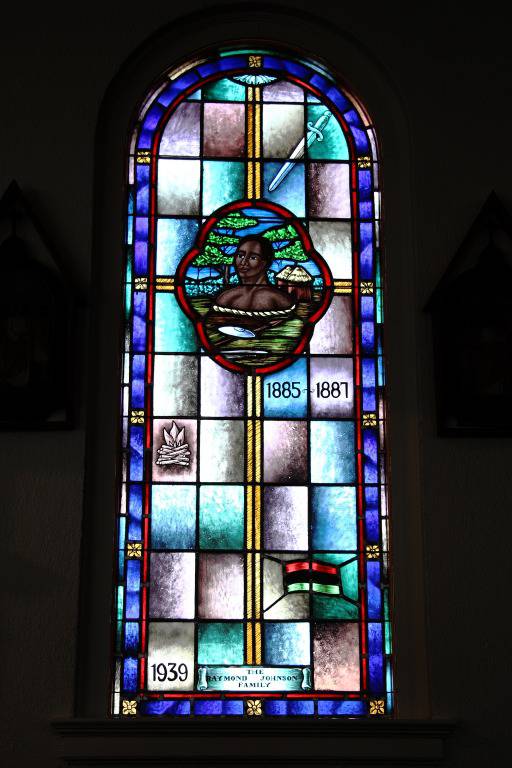 |
Saint Charles Lwanga Window St. Charles Lwanga is a Black Saint. He might be regarded as a St. Thomas More of Africa. Charles Lwanga, Catholic, was principal minister to the King of Uganda when it was decided by the King to restore paganism and national unity by driving out Christianity. Charles led the opposition politically. In the ensuing persecution, Charles was martyred along with more than twenty other Christians who died by burning or the sword. All those who then died for Christ were either Catholic or Episcopalian. The Church honors them all as "African Martyrs." Symbols The window proclaims the fact that St. Ann Parish began as a Black parish. The symbolism, in addition to the medallion choice of St. Charles Lwanga, shows a sword and a fire for burning, the methods by which the African Martyrs died. Also shown are the dates, 1885-1887, of the Uganda Persecution. The reproduction of the American Black Liberation flag indicates that our parish is American, not African. The red, black, green of the flag portray to American Blacks their blood and suffering, the color of their skin, with the green indicating the land and hope. The date, 1939, shows that the parish effort began in that year. Memorial The window is a gift of the Raymond Johnson Family. It is a memorial to present and deceased members of that Family. |
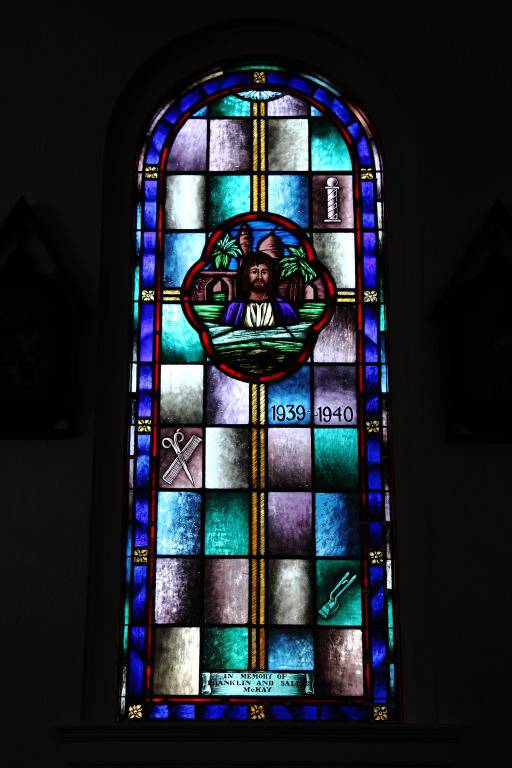 |
Saint Jude Window
MedallionSt. Jude was one of the twelve Apostles of Jesus. Among many of the Catholic faithful he has the reputation of being, "Saint of the Impossible." The belief is that fervent prayer to God through the intercession of St. Jude, never goes without answer. At the time the little group of Fayetteville Black Catholics organized to found their own parish, they adopted St. Jude as their patron and held weekly prayer devotions in his honor. The principal purpose of their prayer was help in founding their own parish. SymbolsMack's Barber Shop was their meeting place. They used it for Sunday Mass, mid-week Devotions and even for a marriage. The barber shop was located on Gillespie Street in a building now demolished. Franklin McKay, a Black barber and a member of the group, owned the shop. The then Bishop of Raleigh, Most Rev. Eugene J. McGuinness, D.D., had given the necessary permissions for these uses of the barber shop. The objects in this window relate to the barber shop beginnings. There is an old-style barber pole as well as hair scissors and comb, and hand-powered clippers. The dates, 1939-1940, indicate the time period in which the shop also served as a church. MemorialThis window is dedicated to Franklin and Sallie McKay and is a gift of Sallie McKay, Franklin's widow. |
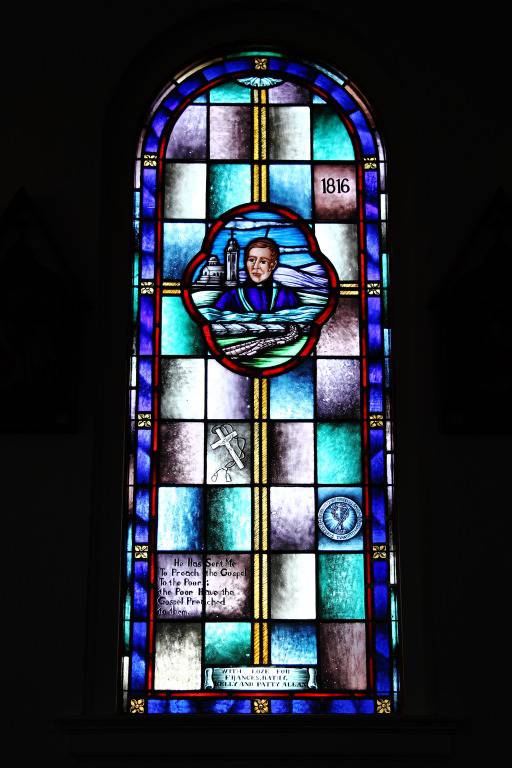 |
Saint Eugene Window
MedallionSt. Charles Joseph Eugene de Mazenod was a 19th Century scion of French nobility. During the French Revolution, the de Mazenod family had to flee France. Eventually, many of the family returned and Eugene, as he was commonly called, studied for the priesthood and was ordained a diocesan priest. Struck by the religious ignorance and indifference widespread after the Revolution, he founded a group of diocesan priests to preach Christ's Gospel in the neglected and priestless areas of southern France. The group was called, "Missionaries of Provence." Later, when Rome approved them as a congregation of the Church, the Holy See gave them the name, "Oblates of Mary Immaculate." Father Eugene later became Bishop of Marseilles. SymbolsThis window tells that members of the Oblates of Mary Immaculate have been with St. Ann Parish from the beginning. Father Ryan who conceived the idea of a Black Parish for Fayetteville is an Oblate of Mary Immaculate. Every Pastor and Associate from that time to the present has been a member of the Oblate Congregation. Symbolism begins in the medallion with the fishing net of Marseilles in front of Father Eugene and the famous shrine of Notre Dame de la Garde (a Marseilles landmark rich in Oblate history) in the background. Other symbols in the window include the founding date of the Oblate Congregation, 1816, the French "mission cross" worn as part of the Oblate religious habit, the original official seal of the Oblate Congregation, and the Oblate motto, excerpted from Isaiah and St. Luke. Memorial"With love for Frances, Kathy, Kelly and Patty Allan" daughters of Mr. and Mrs. Marvin Allan, donors of the window. |
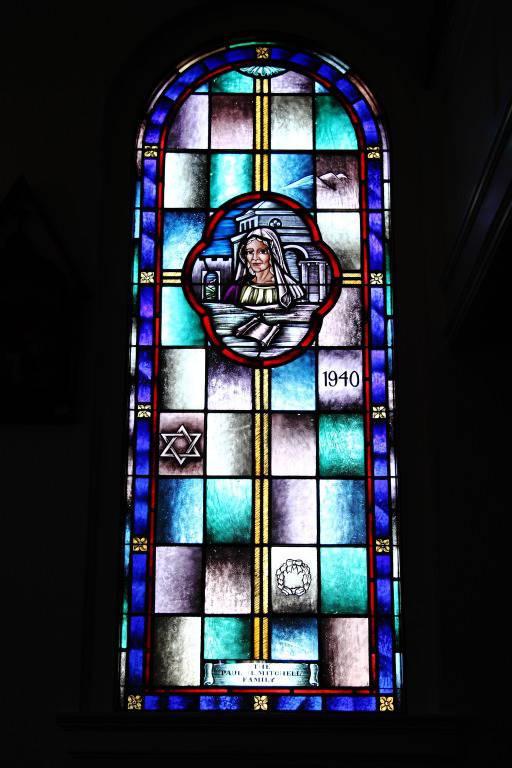 |
Saint Ann Window
MedallionHere we honor St. Ann, mother of the Blessed Virgin Mary and Parish Patroness. St. Ann was a Jewish woman whose husband, according to early Church sources, was named Joachim. Traditional representations of St. Ann show her instructing young daughter, Mary, in the principles of the Law. SymbolsAs noted previously, the Black Catholic group who gathered in Mack's Barber Shop had considerable devotion to St. Jude and prayed to God through his intercession for help in founding their parish. Their prayer received a quick reply. In Boston, Mass, a young priest, Father John Hennessy, was called to his Eternal Reward. At the time of his death, he had been stationed at St. Ann Church in the Neponset area of the city. The Parish raised what was then a considerable sum of money as a memorial to him. The then Bishop Richard J. Cushing (later Cardinal) sent the money to Bishop McGuiness of Raleigh who directed it to the building of the proposed church for the Black Catholics of Fayetteville. The new parish was named St. Ann Parish because of this memorial gift. In this window one sees the symbol of three mountains; the Indian name for the Boston area meant "place of the three mountains" and the earliest name for the English settlement there was"Tri-Mountain Town." The Star of David shows that it was through Mary, daughter of St. Ann, that Christ drew His Jewishness and descent from King David. The date, 1940, is the date of the building of our church; the Christmas wreath indicates that the church was dedicated at the Christmas Season. MemorialThe Paul H. Mitchell Family. The window is a gift of Mrs. Laura T. Mitchell and Mrs. Elaine Newsome. |
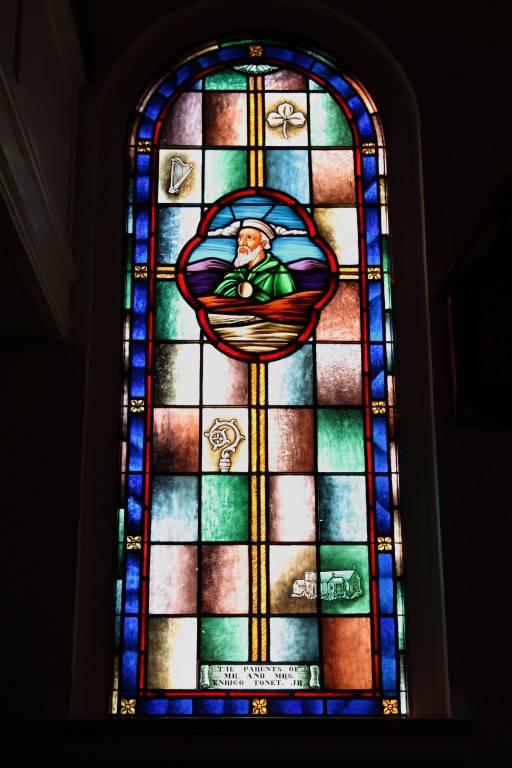 |
Saint Patrick Window Medallion Honored here is St. Patrick, "Apostle of Ireland." The original Catholic parish in Fayetteville took St. Patrick as patron. Because St. Ann Parish developed out of the loins, as it were, of St. Patrick Parish, we are regarded as an ecclesiastical daughter of the elder parish. This window helps to make more precise the church lineage of our parish. In addition, St. Patrick Parish has, over the years, aided St. Ann's efforts in a number of ways; most notably, St. Patrick Parish has housed and cared for the religious sisters who have labored at St. Ann's. SymbolsThe window is adorned with three symbols commonly associated with St. Patrick: the shamrock, the harp, and a Bishop's staff since Patrick was Bishop of Ireland. Included in the symbols is an outline of the building that was St. Patrick Church at the time of the foundation of the Black Catholic Parish in Fayetteville. Today, the building pictured still exists in the Haymount section of the city and is the church home of the local Maronite Rite Parish. MemorialThe Parents of Mr. and Mrs. Enrico W. Tonet, Jr. The window is the gift of Mr. and Mrs. Enrico W. Tonet, Jr. |
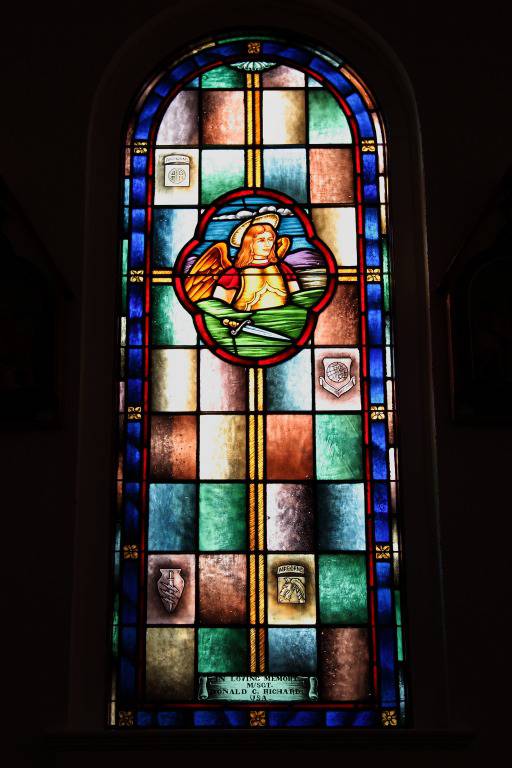 |
Saint Michael Archangel Window
MedallionThe Archangel Michael is of biblical teaching and is leader of the angelic armies of Heaven. He is patron of United States Airborne Forces. While the window honors St. Michael, it is a tribute to the various military forces at Fort Bragg and Pope Air Force Base whose Catholic members have had a long history of association with our parish. People of Fort Bragg and Pope Air Force Base have been especially instrumental in the building and maintenance of our school and in continuing membership in St. Ann Parish. SymbolsScattered throughout the window are military insignia common to Fort Bragg and Pope Air Force Base: insignia of the All American or 82nd Airborne Division which calls Fort Bragg home; of Special Forces, so many of whom train and are stationed at Fort Bragg, and the dragon insignia of the XVIII Airborne Corps. There can also be seen the patch of the Military Airlift Command which locates one of its more important bases of operations at Pope Air Force Base. MemorialThe window is a memorial to Master Sergeant Donald C. Richard USA, and is the gift of his widow, Estelle R. Richard. |
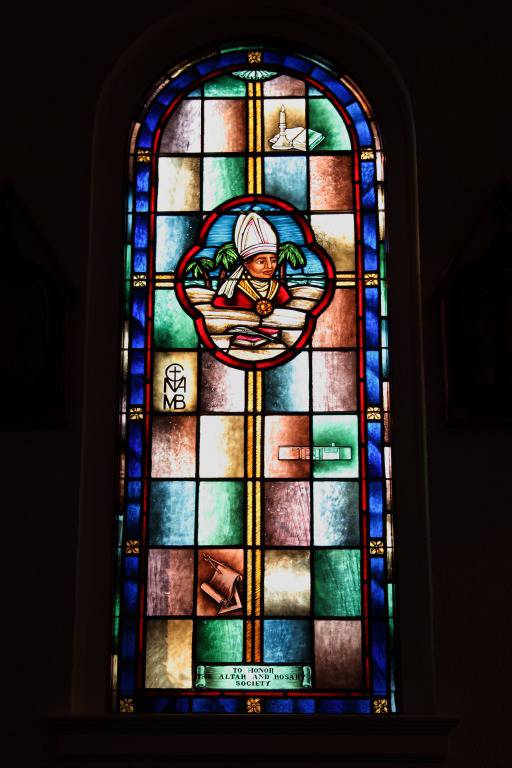 |
The Saint Augustine Window
MedallionThe saint who sets the theme for this window is St. Augustine, 5th Century Doctor of the Church and Bishop of Hippo in North Africa. Augustine, because of his African origins, has long been a patron saint of Black Catholics. To all Catholics Augustine has been a patron saint of education, learning and intellectual defense of Christianity. In this window he helps tell the story of St. Ann Parish educational efforts. SymbolsThe miter which Augustine wears in the medallion is the ecclesiastical headgear of a bishop; the lighted candle with the open book are traditional symbols of the light of learning. The window contains the logotype of the Catholic Negro-American Mission Board. This church organization, headquartered in Washington, D. C., has for many years been instrumental in raising funds for Catholic projects of Black Americans. A large gift from them to the Raleigh Diocese was directed by then Bishop Vincent S. Waters, D.D. to the construction of our school. Devices showing the outline of the school building and the traditional tools of an architect complete the symbolism. The original school was opened in September, 1956. DedicationTo Honor The Altar and Rosary Society, a gift of the people of the parish. |
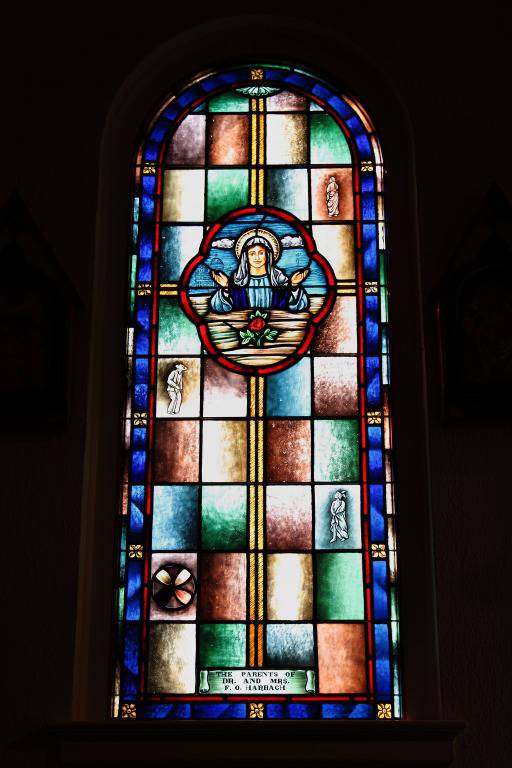 |
Mary, Mother of the Church Window
Medallion"Mother of the Church" is the Blessed Virgin's official title given her by Vatican Council II. The idea of this last window in our series is that we at St. Ann Parish are working toward the goal of Church unity and equality: a community of Faithful in Christ where there is neither Black nor White, bond nor free, but all are one in the Love of God. We know that we have not yet reached that goal, but by the help of the Holy Spirit and the prayers of our Mother, Mother of Christ, we are on our way. SymbolsThere has been as yet no commonly accepted image of Mary as "Mother of the Church." This is our attempt. The biblical Rose of Sharon adorns the medallion; also, two concepts that mean "Church" can be seen in the background: Calvary, where the Church was born from the opened side of Christ, and the dome of the Vatican on the other side of Mary. Seen also in the window are other members of the Church: a woman of Africa carrying a child on her back; an aged Oriental man and an American Indian in traditional garb. There is also a device, our artist's own, indicating the blending of the races of mankind in the Body of Christ on earth. MemorialThe Parents of Dr. and Mrs. F. 0. Harbach. The window is a gift of Dr. and Mrs. Harbach. |
| These two small stained glass windows used to be on both sides of the altar in the original church. They are now in the Reconciliation Room, behind and to the left of the altar. The medallion in the left window depicts the Eucharist, the Body and Blood of Christ. The medallion in the right window depicts Christ as "the Lamb of God who takes away the sins of the world." The small painted medallions of the Empty Tomb of Christ and the butterfly represent the Resurrection. |
|
![]()
During the expansion of our church, we added additional stained glass in The Blessed Sacrament Chapel, behind and to the right of the altar. They were created by Marianne Downs Behle, who was inspired by the lyrics to Song of the Body of Christ.
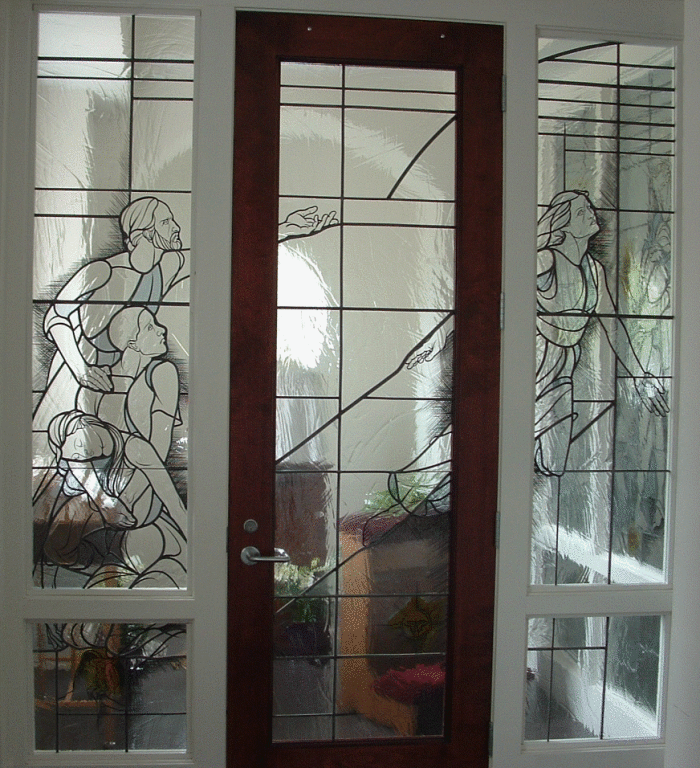 |
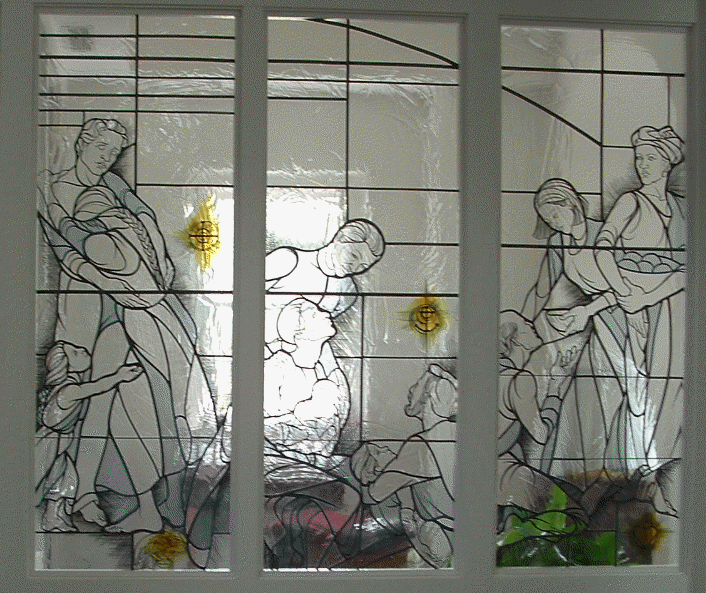 |
Symbols: Dying and Rising, toward the central focus of the Eucharist, with a radiating Cross; Wheat symbolized the Church on earth; Grapes symbolize True Union with the Lord.
Lancet 1: Represents Reconciliation, Forgiveness & Reuniting. It displays the medallion of Foot Washing and the Cross as a symbol of Faith.
Lancet 2: Represents Healing the Broken. It displays the medallion of a Woman Touching Christ's Cloak and the Anchor as a symbol of Hope.
Lancet 3: Represents Feeding the Hungry and Poor. It displays the medallion of Loaves and Fishes and the Heart as a symbol of Charity.